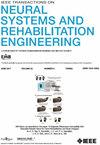Flexor Synergy Assessment and Therapy for Persons With Stroke Using the ULIX Low Impedance Robot
IF 4.8
2区 医学
Q2 ENGINEERING, BIOMEDICAL
IEEE Transactions on Neural Systems and Rehabilitation Engineering
Pub Date : 2025-04-18
DOI:10.1109/TNSRE.2025.3562527
引用次数: 0
Abstract
The flexor synergy after stroke results in involuntary activation of distal muscles when lifting the shoulder against gravity. This contributes to impaired ability to perform activities of daily living. Robotic exoskeletons can be useful in assessing the strength of the synergy and applying therapy modes that promote improved movement patterns. In this study, we evaluated 16 chronic stroke patients using the Ultra Low Impedance eXoskelton (ULIX). The subjects performed two synergy assessment tasks, elbow extension and hand opening while holding shoulder flexion at greater than 70 degrees with various gravity support levels. Joints not part of the tasks were locked in place. During the assessment tasks, increasing gravity support resulted in more elbow extension and reduced grip force; however, EMG contraction ratios of distal muscles compared to deltoids increased when gravity support was increased. A free cup reaching task was performed using several proposed therapy modes. During the cup reaching task, the therapy modes increased range of motion and improved the shoulder-elbow kinematic coordination compared with gravity support alone. There was a strong correlation between synergy expression in the elbow extension task and performance of the cup reaching task. Isolating movement to shoulder flexion and elbow extension during the assessment task resulted in better elbow extension than in the cup reaching task where all joints were free to rotate.使用ULIX低阻抗机器人评估和治疗中风患者的屈肌协同作用
中风后屈肌的协同作用导致不自主地激活远端肌肉,当抬起肩膀对抗重力。这导致日常生活活动能力受损。机器人外骨骼可以用于评估协同作用的强度和应用促进改善运动模式的治疗模式。在这项研究中,我们使用超低阻抗外骨骼(ULIX)对16例慢性脑卒中患者进行了评估。受试者在不同的重力支撑水平下保持肩部屈曲大于70度时进行两项协同评估任务,肘部伸展和手张开。不属于任务的关节被锁定在适当的位置。在评估任务中,增加重力支持导致肘部伸展更多,握力降低;然而,与三角肌相比,远端肌肉的肌电收缩率随着重力支持的增加而增加。使用几种建议的治疗模式进行自由杯子到达任务。在拿杯任务中,与单独的重力支持相比,治疗模式增加了运动范围并改善了肩肘的运动协调。肘关节伸展任务中的协同作用表达与伸杯任务的表现有很强的相关性。在评估任务中,孤立的肩部屈曲和肘部伸展运动比所有关节自由旋转的杯子到达任务中肘部伸展效果更好。
本文章由计算机程序翻译,如有差异,请以英文原文为准。
求助全文
约1分钟内获得全文
求助全文
来源期刊
CiteScore
8.60
自引率
8.20%
发文量
479
审稿时长
6-12 weeks
期刊介绍:
Rehabilitative and neural aspects of biomedical engineering, including functional electrical stimulation, acoustic dynamics, human performance measurement and analysis, nerve stimulation, electromyography, motor control and stimulation; and hardware and software applications for rehabilitation engineering and assistive devices.

 求助内容:
求助内容: 应助结果提醒方式:
应助结果提醒方式:


